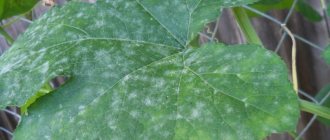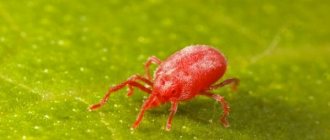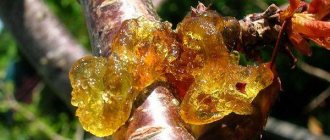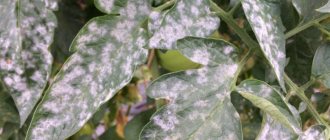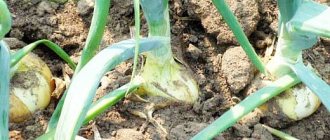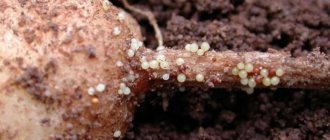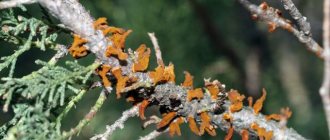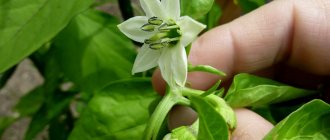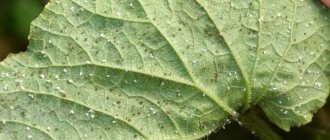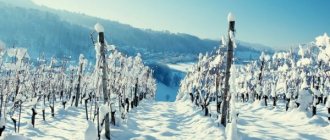Description of the disease
Pear scab disease only at first glance seems frivolous, but in fact this fungal disease weakens the fruit tree, as a result it slows down, the fruits spoil and fall off. The causative agent is a spore actinomycete,
developing in unharvested foliage. The capsules in which the spores overwinter burst under the influence of heat in the spring, and the scab spores are carried by the wind over long distances.
Photo of pear scab disease
Spore reproduction occurs more actively in a humid, warm environment. All fruit trees growing on the site are infected, not just pears. The danger comes from abandoned garden plots where no one cares for cultivated plants, so they can be sources of various diseases, including scab.
EXCELLENT VARIETIES OF PEARS!
Muscovite Pear Marble Pear Summer Duchess Pear (Williams)
Need to know!
It is recommended to treat pears for scab in the spring before the sap begins to flow and in the autumn after the end of leaf fall.
It should be noted that the scab fungus that develops on pears does not affect apple trees and vice versa, but can affect other fruit trees.
This disease can appear unexpectedly on a weakened tree that is frozen in winter, or that bore fruit abundantly in the previous season.
The period of infection of a pear with scab and further spread of the disease lasts from 7 to 60 days.
What is scab and how to deal with it? - video
The main symptoms of scab are:
- the appearance of blackness on the foliage;
- the appearance of growths on shoots and fruits.
Fighting this disease can take a long time if symptoms are discovered late.
Reasons for development
There are factors that increase the likelihood of developing pathology. There is a high risk of pathology if:
- warm temperature within 20-26 degrees;
- rainy weather and high humidity levels;
- depletion of the tree as a result of cracks, breakages, lack of fertilizing;
- poor care.
The older the plant, the higher the likelihood of disease occurrence. The risk group also includes plantings that do not receive enough care. In this case, the plant’s protective functions are reduced. The planting is not able to resist pathogens.
Causes and symptoms of scab
The main symptoms of this disease are easy to determine.
The main signs of pear scab are:
- leaves and shoots burst, swellings and growths appear on them;
- the color of the foliage changes from green to dull olive, the characteristic shine disappears;
- pears and leaves quickly fall off and begin to rot;
- the bark and ripe fruits become covered with cracks and begin to peel off;
- In some fruits, the deformation appears initially; the scab is asymptomatic.
Photo of a sign of scab on a pear
After a latent period, this disease begins a new stage, in which spores actively reproduce on the underside of the leaves. Active formation of spores weakens the pear tree and disrupts water metabolism.
Need to know!
If you do not start fighting scab in a timely manner, then over the next seasons the pear tree will practically not bear fruit.
If rainy weather sets in during the flowering period, scab will certainly damage the flowers. If the symptoms of scab appear at the stage of ovary formation, then the foliage, bark and fruits that are beginning to develop will be damaged. If a gray coating and small spots of black color appear on the fruit, this indicates a severe damage to the tree; such fruits should not be eaten.
Pear scab, how to deal with it - video
The main causes of scab on pear trees:
- increased soil and environmental humidity;
- rotten leaves and fallen fruits remaining in the tree trunks from last season and not removed on time.
The best varieties of pears!
Veles pear Chizhovskaya pear
If fruit trees are planted too close to each other, there is a high probability of the disease quickly spreading throughout the garden plot.
Some varieties have low resistance to growing in regions with rapidly changing weather.
Pears of the same variety are not planted side by side - if one fruit tree is affected by scab, the others will immediately become ill.
Signs of scab on a tree
Rust on a pear: how to treat it
When a tree stops producing fruit, it is difficult to immediately understand what is wrong. At the same time, experienced gardeners know that the absence of an ovary and its instability, weak flowering are signs of a tree being infected with scab. Examining a pear leaf, you can see that it begins to turn black from the bottom, and gradually the hearth will acquire a dark, dull color. As a result, the foliage will fall off and the plant will remain naked ahead of time.
Important! Unhindered propagation of the disease subsequently leads to a deterioration or complete cessation of the fruiting process. The infection affects bud formation and crop formation.
If the fungus infection occurs after the fruit has set, the infection will spread to the fruit. As the fruit develops, the fungus grows and a dark brown dot appears, velvety to the touch. Before the fruit ripens, the spots are round and small in diameter. The more the fruits ripen, the darker the fungus becomes on them. An infected pear can change shape and become gnarled.
Scab can form not only on foliage and fruits. The appearance of cracks and swelling of the bark on the shoot is one of the symptoms of the development of fungal spores inside. When the swelling bursts, the spores spread to the rest of the tree, continuing to cause damage. The infected part of the tree becomes covered with small, almost imperceptible cracks, which then begin to peel off.
How to make scions and rootstocks for an apple tree?
Why is scab dangerous for pears?
When the fruits of pear trees are affected by scab, their productivity suffers - in this case, you cannot expect a rich pear harvest. And when growing these fruit trees on an industrial scale, this means that the pears will suffer greatly, and the harvest will be negligible. If fruits are affected by scab, they should not be eaten or stored.
If preventative treatment of pear trees against scab is not carried out on the garden plot, gardeners do not fight the disease at an early stage of its development, and as a result, they may lose most of their plantings. Pears can become sick for several years, stop bearing fruit and in many cases simply die.
Important!
To prevent the spread of scab disease in the garden, it is necessary to plant stone fruit trees (plums, peaches, apricots) next to the pear.
Varieties resistant to scab
To think less about how and with what to treat trees, choose scab-resistant varieties for your garden. Among them:
- Annushka.
- Belarusian late.
- January.
- Rusanovskaya.
- Yeseninskaya.
- Oryol beauty.
- Nerussa.
- Other.
At the same time, high resistance is not synonymous with 100% protection against fungus - regularly inspect the plantings and take measures if necessary. “Easy” prevention for resistant varieties will also not be superfluous. Their scab control measures are the same as for other pears.
Scab-resistant pear varieties get sick much less often, but this does not mean that they don’t get sick at all.
Disease control on pear trees
The first rule of any gardener is
to regularly check the fruit trees in the garden for disease or pest damage at the beginning of the spring season and throughout the summer.
When the first signs of scab appear, it is necessary to begin treatment of diseased pears and carry out preventive treatment of other fruit trees to eliminate the possibility of the disease spreading.
Most gardeners take measures to disinfect the garden in advance, before the scab appears, while others have to deal with the disease after it appears on the pear in the summer.
Currently, there are a large number of effective chemicals that can effectively combat the fungus that causes scab.
Scab. Treatment and prevention. Garden diseases - video
Features of the disease and pathogen
Scab is a common fungal disease that most often affects apple and pear trees. But the deviation may spread to other plants in the garden. The causative agent of the disease is Venturia pirina Aderh. This subspecies is typical for pears. Other plants are attacked by other fungi.
The main danger of the disease is the complete destruction of the crop.
Traditional methods of combating pear scab
- Dry mustard.
1 sachet of this substance is dissolved in a bucket of heated water. Treatment of pears with mustard solution against scab is carried out during flowering and mass formation of ovaries, during intensive ripening of fruits. - Salt.
1 kg of salt is dissolved in a bucket of water. You can treat pear trees with a saline solution against scab before flowering or after the ripe fruits have been fully harvested. This solution helps dry out moisture, which prevents the active spread of fungal spores. - Potassium permanganate.
Potassium permanganate is dissolved in a bucket of heated water to obtain a solution of medium concentration. Treatments of pears with potassium permanganate for scab are carried out in the evening hours. - Field horsetail.
A decoction of this plant should be prepared. To do this, the vegetative mass of the plant is crushed, poured with boiling water and infused for 48 hours. The decoction is poured into the trunk circles of the pear at the beginning of the spring period.
Important!
It is necessary to disinfect not only the tree itself, but also the trunk circle with a diameter of at least 2.5 m from the base of the tree.
Processing schedule
Any tree disease and its treatment must be approached comprehensively - and scab is no exception. To get rid of this disease once and for all, treat apple and pear trees in the spring with a solution of copper sulfate and lime. Several procedures per year will be enough.
To make treatments as effective as possible, alternate medications.
Alternate spring spraying with colloidal sulfur/copper chloride/Bordeaux mixture with copper sulfate gives good results. Trees are treated 5-6 times per season in very severe cases.
When the buds swell and form, you need copper sulfate; when the buds are forming and after flowering stops, use Speed. Winter varieties are sprayed with copper sulfate and Skor towards the end of summer or early autumn.
Untimely sanitary pruning is a bad contribution to the development of the garden. In neglected plantings, infections spread most actively, spreading to well-groomed areas and healthy trees. When you find signs of scab infection, begin to treat not only the diseased pear itself, but also all its neighbors. This article will tell you about scab on an apple tree.
Treatment times and basic rules
It is best to treat pear fruit trees for scab before the ovaries appear or after collecting ripe fruits in the fall. Any drugs actively fight the fungus for 12-14 days. It is recommended to carry out alternate treatments with fungicidal preparations and folk remedies. The timing of such treatments also depends on the weather conditions in the region where pear trees are grown.
Photo of the pear processing table
If after spraying it begins to rain, the moisture will wash away the preparations from the above-ground parts of the trees and will only contribute to the development of the disease.
In the central regions of Russia, spraying pears against scab is carried out from the first ten days of April to the first ten days of June, in the south - in early spring or late autumn.
In hot weather, trees are not treated. When the disease is detected late, they begin the fight with gentle means at any time.
First you need to remove all damaged and dried shoots. And if the pear is severely damaged, you can do without pruning and spray immediately.
After the effect of the scab drug wears off, it is necessary to apply organic fertilizers to the tree trunk circles after watering, simultaneously with loosening the soil.
It is not recommended to treat trees too often.
Method 2
“Blue spraying” is very popular among gardeners, especially since it gives good results. Trees are treated with Bordeaux mixture; if you are doing this for the first time, use a 3 percent solution. You can replace this drug with copper oxychloride. Spraying begins at the top of the trees and lasts from three to six days, at which time the sharp tips of the buds round and become shaggy. After flowering ends, the procedure should be repeated, but with a one percent solution. If the weather is rainy outside, you will have to spray the trees two more times, maintaining an interval of two weeks.
When to treat pears for scab
You can use the following scheme for treating pears for scab:
- first spraying - treatment of pear trees with copper sulfate for scab in the spring, before the buds swell;
- spraying the pear with any fungicidal preparation suitable for it (for example, Horus, Topsin-M) during the formation of flower buds;
- then the pear should be treated against scab for the third time (with a fungicidal agent) - this is carried out after the trees have finished flowering;
- after 2 weeks, spraying with fungicide is repeated again;
- The last treatment of pears for scab occurs at the end of summer - beginning of autumn, after harvest.
Such measures to treat pear scab should be carried out in case of severe damage to trees by the disease.
Method 3
In recent years, biological preparations have become very popular: Strobi and Hom, and the systemic fungicide Skor. They are used when the blue spray treatment has not shown results. These drugs are stable even in rainy weather. After time you will be able to judge their effectiveness. "Skor" is used for repeated spraying after flowering; it is a systemic fungicide. This drug really works. For four tall trees, use one 2 ml ampoule, which is diluted in 10 liters of water. The last spraying should be carried out a month before the start of harvest, not later.
Preventive measures for pear scab
It is important to properly care for your garden and prevent the occurrence of scab. Mature fruit trees should be regularly inspected at the beginning of the spring and autumn in order to detect symptoms of the disease in time.
The following rules must be followed to eliminate the possibility of scab on the pear:
- plant these trees in places well lit by sunlight;
- maintain a distance of 3 m between identical pear varieties;
- do not grow fruit trees too close to each other, regularly prune the trees, removing branches growing inside the crown and contributing to its thickening;
- the sections must be disinfected with a weak solution of potassium permanganate and covered with garden varnish;
- tree trunk circles must be kept clean; weeds, fallen fruits and leaves must be constantly removed;
- In the spring and autumn periods, sanitary pruning of pear trees is carried out.
Need to know!
Preventive treatments are useless if the pear is already affected by scab.
INTERESTING!
Pruning an apple tree in autumn
Disease prevention
You can prevent pear scab damage if you follow simple preventive measures. They cannot completely eliminate the likelihood of developing the disease, but they can reduce the risks to a minimum.
Prevention measures:
- Plant trees in sunny, open areas.
- Avoid overcrowding of plantings.
- After fruiting, promptly remove fallen rotting fruits.
- It is necessary to promptly treat wounds and cracks in the bark with garden varnish.
- Whitewash the trunk and skeletal branches.
- In late autumn, collect and burn all fallen leaves.
It is extremely important to clean the crown of broken and damaged branches every year.
Features of scab infection
Scab and other fungal diseases first affect leaves and shoots. Photo: mirsadovodnik.ru
- The fungus overwinters in soil and plant debris. Therefore, gardeners need to thoroughly clean the area in the fall and burn all remains away from the garden. This will reduce the risk of infection.
- There are pears that are not immune to this disease. These varieties are: Ilyinka, Forest Beauty, Sapezhanka.
- Proper care, especially fertilizing, will help the pear become more resistant to diseases and pests.
After pruning, cover any wounds with garden varnish. Photo: fruitree.ru
The author of the video tells how to deal with scab on a pear
Focuses on which remedy works most effectively:. https://www.youtube.com/embed/LSkby8LaMds
How dangerous is the disease?
Fungal disease is fraught with a number of negative consequences:
- after harvesting the fruits, during their storage, the spots increase, cover the entire peel, the harvest is considered lost;
- due to the appearance of cracks on the fruit, since they do not have a waxy coating, they turn out to be insignificant, the fruits are small.
See also
Description and characteristics of Conference pear variety, planting and care
Read
The most dangerous scab is the lack of harvest.
Diseases of pear leaves and their treatment
Powdery mildew is the most common disease, affecting mainly the leaves and young shoots of fruit trees. This disease can be diagnosed by a whitish coating covering the ground organs, which over time becomes denser and acquires a reddish-brown tint. The parts of the pear covered with plaque dry out, the leaves fall off, and the shoots become deformed. Powdery mildew progresses in conditions of high air humidity. The causative agent of the disease overwinters on the affected shoots and does not die even in severe frosts, and in the spring it takes up sabotage with renewed vigor.
Methods of struggle. During autumn and spring pruning, remove shoots affected by powdery mildew and burn them, and treat the pear with colloidal sulfur. During the growing season, you can limit the spread of infection using systemic fungicides, for example, Fundazol and Sulfite, which can be purchased at any garden pavilion. An effective folk remedy is a composition prepared according to this recipe: 10 g of liquid soap and 50 g of soda ash are dissolved in 10 liters of water. The pear varieties Moskvichka, Yanvarskaya and Dukhmyanaya are resistant to powdery mildew.
Diseases of pear leaves and their treatment
Rust affects pear and other plants if juniper, which is the main host of the fungus, grows nearby. Signs of rust appear mainly in the fall, during the rainy season: rounded yellow or red spots form on the green organs of the plant, sometimes edged with a purple rim, and yellow-green plates form on the underside of the leaves. As the disease progresses, black dots may appear - pycnidia of the fungus, and the red formations swell, burst, and the infection spreads throughout the garden and infects other plants. In trees affected by rust, the immune system is weakened and winter hardiness is reduced.
Methods of struggle. At the first signs of rust infection, the tree should be treated with a systemic fungicide - Skor, Bayleton, Delan, Fundazol, Topsin M or Tarcel. However, rust cannot be dealt with with a one-time treatment, so be prepared for a serious struggle. In the spring, for preventive purposes, a two-stage treatment of pears with Bordeaux mixture is carried out: during bud break and after flowering. The pear varieties Letniy Williams, Skorospelka, Suniani, Sakharnaya, Nanaziri, Gulabi, Gordzala, Ilyinka, Duchess Letniy and others are relatively resistant to rust.
Septoria, or white spot, is a disease of aging or neglected trees. First, light brown spots appear on the leaves of the pear, then they lighten from the center to the edges, and only the border around the spots remains dark. Leaves affected by spotting dry out and fall off prematurely, the viability, winter hardiness and productivity of the tree decreases.
Methods of struggle. No special measures are taken against septoria; preventative spring and autumn garden treatments are sufficient.
The appearance of black spots on pear leaves
If black spots appear on the leaves of a pear tree, this indicates the development of the disease.
Scab
Signs of scab development on pears appear in early spring. Dark spots of varying sizes form on young leaves. If therapeutic measures are not taken, the spots will spread to the fruits.
Control measures:
- promptly remove affected leaves and branches;
- when the first signs of disease development appear, the pear is sprayed with a disinfectant composition (5% solution of Bordeaux mixture).
Prevention:
- regular disinfection treatment will help protect the pear from scab - the first spraying of the tree is carried out at the moment of bud formation (treatment with a 3% solution of Bordeaux mixture);
- after the tree has faded, disinfection is carried out again, but with a 1% solution of Bordeaux mixture;
- 3 weeks after repeated spraying, the pear is treated with one of the indicated drugs - Ditan, Skor, Horus (the disinfectant composition is prepared according to the instructions attached to the drug);
- maintain distance between trees.
https://youtube.com/watch?v=YEurCBndhz8
Black cancer
The disease often develops on older fruit trees. The appearance of black spots of various sizes is found not only on the leaves; this pathological symptom can affect the trunk of the tree, its fruits, and also branches. The areas affected by cancer on the pear die, leaving wounds in their place.
Control measures:
- the affected parts of the pear must be urgently removed and disposed of (burned);
- treat wounds with a disinfectant solution (5% copper sulfate solution)
Prevention:
spray the pear at the time of flowering, and also a month after flowering with a disinfectant solution (1% mixture of Bordeaux mixture).
Bacterial burn
The second name of the disease is bacteriosis. On a pear tree affected by bacteriosis, the leaves, trunk, fruits and branches become covered with dark or black spots. The affected leaves curl, and the fruits stop growing, darken and rot right on the tree. Visually, the pear looks as if it was damaged by fire.
Control measures:
- if most of the pear is damaged, the tree must be uprooted and destroyed (burned);
- if bacteriosis has just begun, then the pear is treated with a disinfectant (1% solution of copper sulfate), fungicides (5% Azofos) and antibacterial compounds (Rifampicin, Gentamicin).
Prevention:
In the spring, the tree is sprayed with a disinfectant composition (1% solution of copper sulfate).
